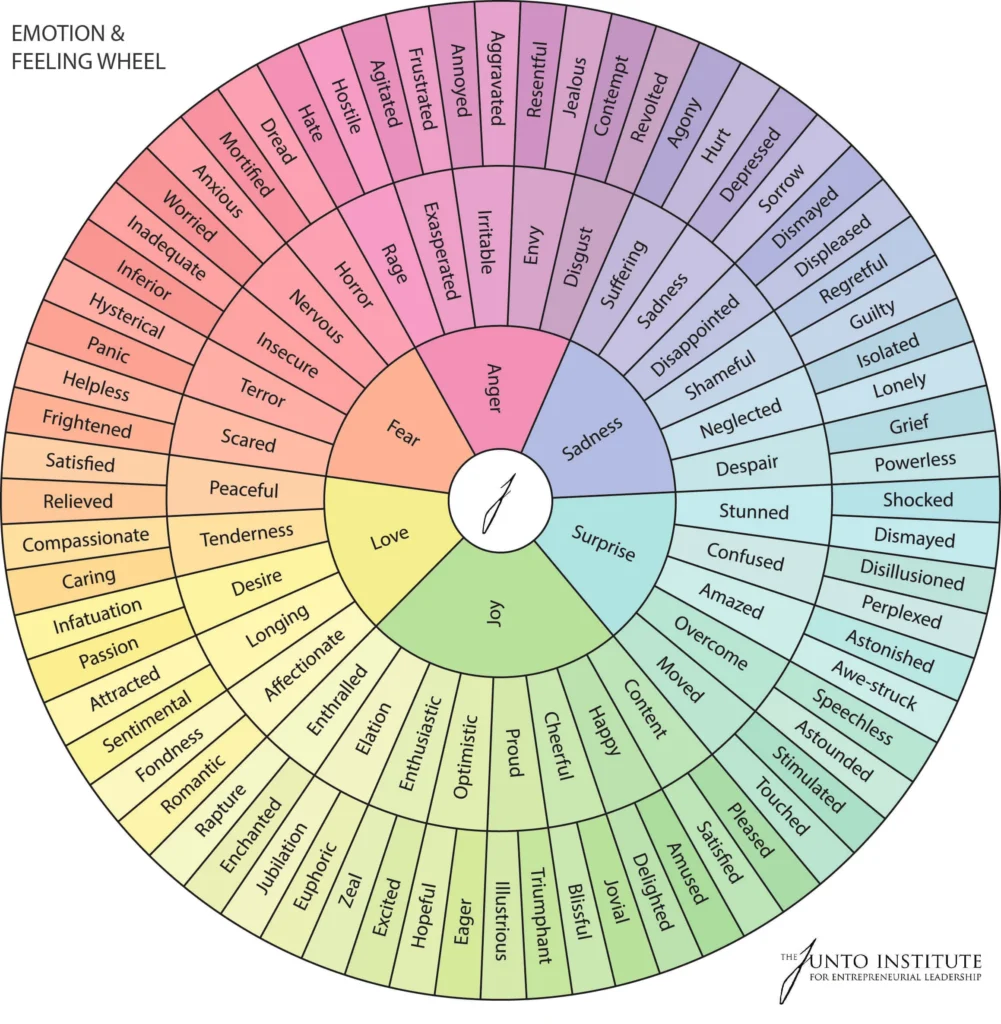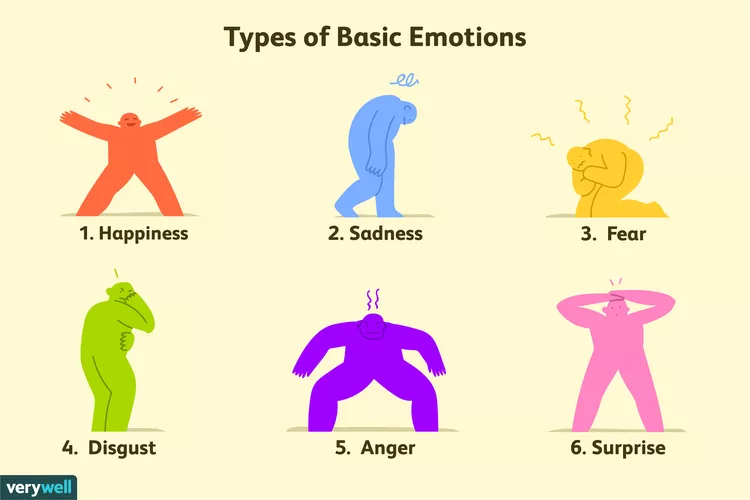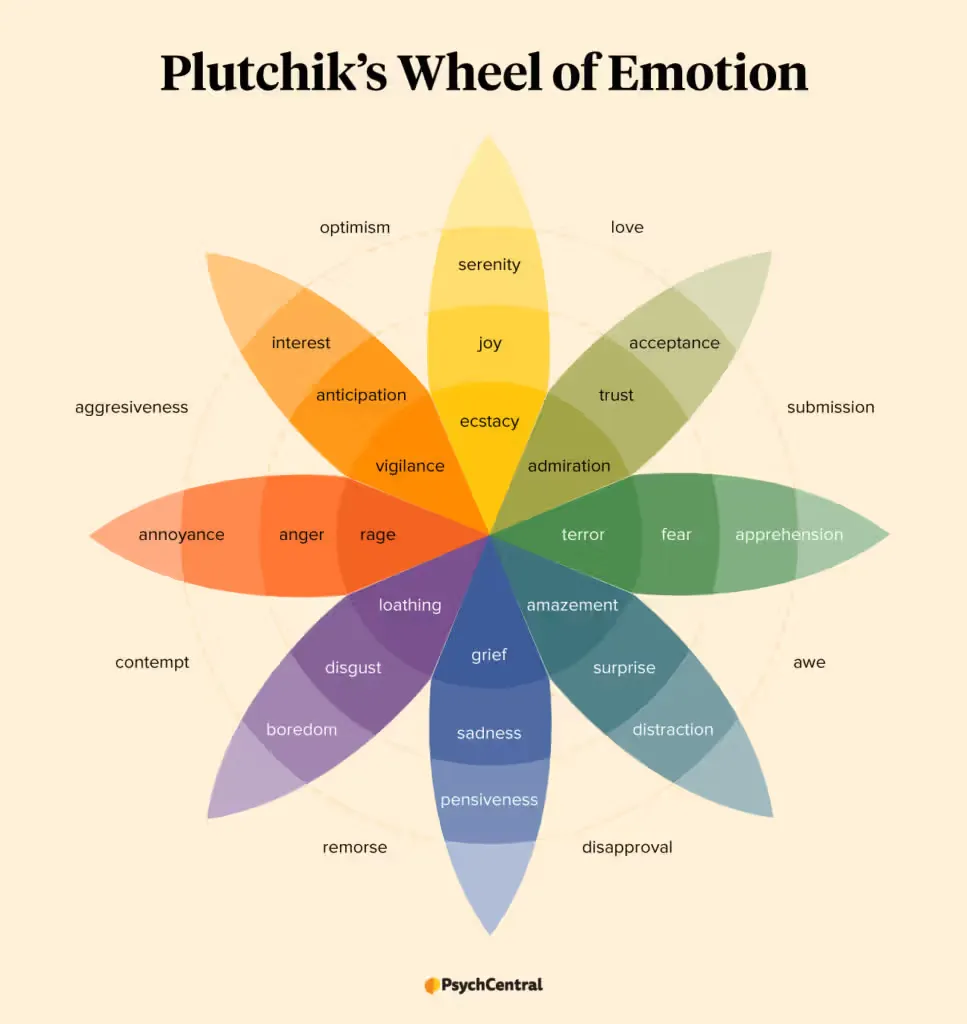Table of Contents
I. Introduction to Emotions List
“Have you ever wondered about the diverse range of emotions that color the canvas of human experience? Welcome to a journey of exploration into the intricate realm of human emotions.
We experience a myriad of feelings that shape our perceptions, behaviors, and relationships. At the core of this exploration lies the concept of an emotions list, a comprehensive catalog of the diverse range of emotions that define the human experience.
In understanding emotions, we often refer to the notion of basic emotions, a foundational framework that categorizes emotions into distinct categories.
From the six basic emotions proposed by psychologists to the expanded list of eight or even more basic emotions, the study of human emotions continues to evolve, revealing the complexity and richness of our emotional landscape.
While basic emotions such as joy, sadness, anger, fear, surprise, and disgust form the cornerstone of our emotional vocabulary, our emotional lives extend beyond these primary states.
We encounter a spectrum of emotions, from the fleeting moments of excitement to the profound depths of grief, each contributing to the tapestry of our emotional experiences.
Emotions are not merely abstract concepts but tangible manifestations that influence our physical health, interpersonal relationships, and overall well-being.
From the subtle nuances of facial expressions to the intricate dance of neurotransmitters in our brains, emotions bridge the gap between our inner world and external reality.
II. What is an Emotions List?
In the vast landscape of human emotions, an emotions list serves as a navigational tool, offering a comprehensive catalog of the myriad feelings that individuals may encounter. But what exactly constitutes an emotions list, and how does it help us better understand and articulate our innermost feelings?
Defining an Emotions List:
An emotions list is a curated compilation of emotion words that categorize and describe the diverse range of feelings experienced by individuals. From the basic emotions proposed by psychologists to more nuanced and complex states, an emotions list provides a structured framework for identifying and labeling emotions.
Purpose and Function:
The primary purpose of an emotions list is to enhance self-awareness and emotional literacy by providing individuals with a vocabulary to express their feelings more accurately. By offering a range of emotion words, an emotions list enables individuals to articulate their inner experiences with greater precision and clarity.
Additionally, an emotions list serves as a valuable reference tool for mental health professionals, educators, and researchers, facilitating communication and analysis in the field of psychology and beyond.
Components of an Emotions List:
Emotions lists vary in scope and depth, with some focusing on basic emotions such as joy, sadness, anger, fear, surprise, and disgust, while others include a broader spectrum of emotions. Some emotions lists categorize emotions based on primary, secondary, and tertiary levels, while others organize emotions according to specific themes or contexts.
Regardless of its format, an emotions list typically includes a range of emotion words accompanied by brief descriptions or definitions to aid understanding.
Utilizing an Emotions List in Practice:
Individuals can use an emotions list as a practical tool for self-reflection, communication, and emotional regulation. By familiarizing themselves with the various emotion words and their meanings, individuals can develop a deeper understanding of their own emotional experiences and those of others.
Mental health professionals may incorporate an emotions list into therapy sessions as a way to facilitate emotional exploration and expression. Educators can use emotions lists in classrooms to promote emotional intelligence and empathy among students.
In summary, an emotions list is a valuable resource for enhancing emotional awareness and communication, providing individuals with the language to navigate the complex landscape of human emotions with clarity and insight.

III. Exploring Common Emotions
As we delve deeper into the realm of human emotions, it becomes evident that certain feelings resonate universally among individuals, forming the foundation of our emotional experiences. In this section, we will explore a selection of common emotions included in emotions lists, examining their characteristics, triggers, and implications for our well-being.
Joy:
Joy is a profound and uplifting emotion characterized by feelings of happiness, contentment, and fulfillment. It is often triggered by experiences of success, love, or gratitude, eliciting a sense of inner peace and satisfaction.
Understanding joy allows us to savor life’s moments of bliss and cultivate a more positive outlook, contributing to our overall sense of well-being and fulfillment.
Sadness:
Sadness is a natural and inevitable emotion that arises in response to loss, disappointment, or grief. It is characterized by feelings of sorrow, melancholy, and longing, often accompanied by tears and a sense of emptiness.
Exploring sadness enables us to acknowledge and process our emotions in times of hardship, fostering resilience and emotional growth in the face of adversity.
Anger:
Anger is a powerful and intense emotion that arises in response to perceived threats, injustices, or frustrations. It is characterized by feelings of irritation, resentment, and hostility, often accompanied by physiological arousal and a desire to assert control.
Channeling anger constructively allows us to address underlying issues and advocate for our needs while avoiding destructive behaviors that may harm ourselves or others.
Fear:
Fear is a primal and instinctual emotion that emerges in the presence of danger, uncertainty, or perceived threats to our safety. It is characterized by feelings of anxiety, apprehension, and vulnerability, often triggering a fight-flight-freeze response.
Confronting fear empowers us to confront our anxieties, overcome obstacles, and navigate life’s challenges with courage and resilience.
Surprise:
Surprise is a fleeting and spontaneous emotion that arises in response to unexpected events or stimuli. It is characterized by feelings of astonishment, wonder, and curiosity, often accompanied by widened eyes and a quickened heartbeat.
Embracing surprise allows us to embrace life’s unpredictability and embrace the beauty of the unexpected, fostering a sense of wonder and excitement in our daily lives.
By exploring these common emotions and their nuances, we gain insight into the intricacies of human experience, deepening our understanding of ourselves and others.

Below is an explanation of the Feelings Wheel listed:
Accepting: Being open and receptive to what is, without resistance or judgment.
Aliveness / Joy: A feeling of vitality and enthusiasm for life, often accompanied by a sense of excitement, energy, and zest. It involves embracing life with passion and joy, and feeling fully alive in each moment.
Amazed: A state of wonder and astonishment in response to something extraordinary or unexpected. It involves being impressed or awed by the beauty, complexity, or mystery of the world around us.
Awe: A profound sense of reverence and admiration inspired by something grand or sublime. It involves feeling humbled and uplifted by the vastness, beauty, or power of nature, art, or human achievement.
Angry / Annoyed: Feeling irritation or frustration due to perceived provocation or inconvenience. It involves experiencing heightened emotions such as anger, annoyance, or agitation.
Agitated: Feeling restless, unsettled, or disturbed, often accompanied by physical or mental agitation. It involves experiencing inner turmoil or agitation, with a sense of unease or discomfort.
Aggravated: Feeling exacerbated or intensified irritation or frustration, often in response to persistent annoyances or aggravations. It involves feeling increasingly annoyed, angered, or aggravated by a situation or individual.
Adventurous: Feeling eager to explore new experiences, take risks, and embrace uncertainty. It involves a sense of excitement, curiosity, and openness to new possibilities and adventures.
Brave: Feeling courageous and fearless in the face of danger, adversity, or uncertainty. It involves a willingness to confront and overcome fears, challenges, or obstacles with bravery and resilience.
Bliss: An intense and transcendent state of happiness and contentment, often described as a state of pure joy or ecstasy. It involves feeling deeply satisfied and at peace with oneself and the world.
Bitter: Feeling resentment or cynicism towards a perceived injustice or unfairness. It involves harboring negative feelings such as resentment, cynicism, or disillusionment.
Calm: A state of tranquility and peace, free from agitation or disturbance.
Centered: Feeling grounded and balanced, with a sense of inner stability and equilibrium.
Content: A feeling of satisfaction and fulfillment with one’s current circumstances or state of being.
Contempt: Feeling disdain or scorn towards someone or something considered inferior or unworthy. It involves experiencing a sense of superiority or disdain towards others.
Courageous / Powerful: Feeling brave, strong, and capable of facing challenges or adversity with resilience and determination. It involves a sense of inner strength, confidence, and courage to overcome obstacles and pursue one’s goals.
Capable: Feeling competent, skilled, and able to handle tasks or responsibilities effectively. It involves a sense of confidence and self-assurance in one’s abilities and capacities.
Confident: Feeling self-assured, poised, and secure in one’s own worth and abilities. It involves a belief in oneself and one’s capacity to succeed in achieving goals or overcoming challenges.
Cynical: Feeling distrustful or skeptical towards people’s motives or intentions. It involves adopting a pessimistic or distrustful attitude towards life or human nature.
Delighted: A feeling of pleasure and enjoyment derived from something delightful or pleasing. It involves experiencing joy, satisfaction, or amusement in response to positive experiences or events.
Disdain: Feeling contempt or scorn towards someone or something considered unworthy or inferior. It involves experiencing a sense of superiority or disdain towards others.
Disgruntled: Feeling dissatisfied or displeased with a situation or circumstance. It involves harboring negative feelings such as dissatisfaction, frustration, or resentment.
Disturbed: Feeling unsettled, perturbed, or troubled by something unsettling or distressing. It involves experiencing emotional or psychological discomfort due to disturbing or distressing stimuli.
Daring: Feeling bold, adventurous, and willing to take risks or embrace new opportunities. It involves a readiness to step outside of one’s comfort zone and pursue ambitious or challenging endeavors.
Determined: Feeling resolute, committed, and unwavering in the pursuit of goals or objectives. It involves a strong sense of purpose and perseverance in the face of obstacles or setbacks.
Edgy: Feeling nervous, irritable, or tense, often due to heightened sensitivity or apprehension. It involves being on edge or feeling jittery, with a sense of unease or tension.
Exasperated: Feeling frustrated, annoyed, or irritated to the point of exasperation. It involves experiencing heightened irritation or frustration, often in response to repeated annoyances or setbacks.
Eager: A feeling of anticipation and enthusiasm for something desired or anticipated. It involves being excited and eager to pursue opportunities, challenges, or adventures.
Ecstatic: An overwhelming feeling of ecstasy and euphoria, often accompanied by intense joy, exhilaration, and elation. It involves experiencing a state of heightened emotional and physical pleasure.
Enchanted: A feeling of enchantment and wonderment, often inspired by magical or enchanting experiences. It involves feeling captivated and entranced by beauty, mystery, or awe-inspiring moments.
Energized: A feeling of vitality, vigor, and zest for life, often accompanied by a surge of physical or mental energy. It involves feeling invigorated and motivated to take on challenges or pursue goals.
Engaged: A feeling of involvement and connection in one’s activities, relationships, or pursuits. It involves being fully immersed and invested in the present moment, with a sense of purpose and commitment.
Enthusiastic: A feeling of excitement, passion, and eagerness for something of interest or importance. It involves expressing genuine enthusiasm and zeal for life, work, or personal endeavors.
Excited: A feeling of anticipation and thrill in response to something stimulating or exciting. It involves experiencing a rush of adrenaline and excitement, often accompanied by a sense of anticipation or expectation.
Free: A feeling of liberation and freedom from constraints, limitations, or obligations. It involves feeling unburdened and unrestricted, with a sense of autonomy and self-determination.
Fulfilled: Experiencing a deep sense of satisfaction and completion, often as a result of achieving one’s goals or desires.
Frustrated: Feeling thwarted or hindered in one’s efforts or desires, often leading to feelings of irritation or discontent. It involves experiencing emotional tension or dissatisfaction due to unmet expectations or obstacles.
Furious: Feeling intense anger or rage, often accompanied by a desire for retaliation or retribution. It involves experiencing overwhelming anger or rage, with a strong urge to express or release pent-up emotions.
Grounded: Feeling rooted, stable, and centered in one’s own identity and values. It involves a sense of inner stability and equilibrium, even in the midst of change or uncertainty.
Grouchy: Feeling irritable, grumpy, or ill-tempered, often due to fatigue, stress, or discomfort. It involves being in a bad mood or feeling easily annoyed or irritated.
Happy: A state of well-being and contentment, characterized by positive emotions such as joy, pleasure, and satisfaction. It involves feeling emotionally and psychologically fulfilled, with a sense of overall happiness and fulfillment.
Hostile: Feeling antagonistic or confrontational towards others, often accompanied by feelings of anger or resentment. It involves harboring negative feelings or intentions towards others, with a desire to assert dominance or control.
Impatient: Feeling restless or frustrated with delays or obstacles, often accompanied by a desire for immediate gratification or resolution. It involves experiencing a lack of tolerance or forbearance towards waiting or uncertainty.
Irritated: Feeling annoyed, bothered, or provoked by something or someone. It involves experiencing mild to moderate annoyance or frustration, often in response to minor irritations or inconveniences.
Irate: Feeling intensely angry or incensed, often in response to perceived provocation or injustice. It involves experiencing overwhelming anger or rage, with a strong desire to express or assert one’s emotions.
Inspired: A feeling of creativity, motivation, and enthusiasm sparked by something inspiring or uplifting. It involves being moved or motivated by ideas, experiences, or individuals that ignite passion and creativity.
Invigorated: A feeling of revitalization and renewed energy, often resulting from rest, relaxation, or physical activity. It involves feeling refreshed, rejuvenated, and ready to take on new challenges.
Lively: A feeling of liveliness and vitality, characterized by energy, enthusiasm, and a zest for life. It involves feeling animated and spirited, with a sense of vibrancy and zest.
Moody: Feeling prone to frequent or unpredictable changes in mood, often without apparent cause. It involves experiencing fluctuating emotions or temperamental shifts, leading to unpredictable behavior or reactions.
On edge: Feeling tense, nervous, or apprehensive, often due to heightened sensitivity or anticipation of danger. It involves being in a state of heightened alertness or vigilance, with a sense of unease or anxiety.
Outraged: Feeling intensely offended or affronted by something perceived as unjust or offensive. It involves experiencing overwhelming anger or indignation, often in response to perceived violations of one’s values or principles.
Open: Embracing new experiences, ideas, and perspectives with a sense of curiosity and receptivity.
Patient: Having the ability to wait calmly and without frustration, even in challenging situations.
Peaceful: Feeling a sense of serenity and harmony within oneself and with the world around them.
Present: Being fully engaged and aware in the current moment, without dwelling on the past or worrying about the future.
Passionate: A feeling of intense emotion, desire, or enthusiasm for something or someone. It involves experiencing strong feelings of love, desire, or commitment, often accompanied by a sense of urgency or intensity.
Playful: A feeling of lightheartedness and enjoyment derived from engaging in playful or spontaneous activities. It involves embracing a sense of fun, spontaneity, and creativity in one’s interactions and experiences.
Pissed: Feeling extremely angry or irritated, often accompanied by a desire to express or vent one’s emotions. It involves experiencing intense frustration or annoyance, with a strong urge to retaliate or confront the source of one’s anger.
Proud: Feeling a sense of satisfaction and pride in one’s accomplishments, qualities, or attributes. It involves recognizing and appreciating one’s own worth, achievements, and contributions.
Resentful: Feeling bitter or aggrieved towards someone or something perceived as causing injury or injustice. It involves harboring feelings of bitterness, indignation, or resentment towards others.
Radiant: A feeling of brightness and positivity that emanates from within, often associated with inner beauty, confidence, and vitality. It involves projecting a sense of warmth, positivity, and charm to others.
Refreshed: A feeling of renewal and revitalization, often resulting from rest, relaxation, or self-care. It involves feeling reenergized, rejuvenated, and ready to face the day with renewed vigor.
Rejuvenated: A feeling of rejuvenation and renewal, characterized by a sense of restored energy, vitality, and well-being. It involves feeling revitalized and refreshed, both physically and mentally.
Renewed: A feeling of renewal and rebirth, often accompanied by a sense of optimism and hope for the future. It involves experiencing a fresh start or new beginning, with a sense of empowerment and possibility.
Relaxed: Feeling at ease and free from tension or stress, both physically and mentally.
Satisfied: A feeling of contentment and fulfillment derived from meeting one’s needs, desires, or expectations. It involves feeling gratified and pleased with one’s accomplishments, experiences, or circumstances.
Serene: Experiencing a profound sense of calmness and tranquility, often in the midst of chaos or uncertainty.
Strong: Feeling empowered, resilient, and capable of withstanding adversity or challenges. It involves a sense of physical, emotional, or mental strength and fortitude.
Trusting: Having confidence in oneself, others, or the universe, and believing that things will work out for the best.
Thrilled: A feeling of excitement and exhilaration in response to something exciting or surprising. It involves experiencing a rush of adrenaline and excitement, often accompanied by a sense of anticipation or delight.
Upset: Feeling emotionally disturbed, distressed, or troubled by something upsetting or distressing. It involves experiencing emotional discomfort or distress, often in response to adverse events or circumstances.
Vibrant: A feeling of vitality and energy, characterized by brightness, enthusiasm, and liveliness. It involves feeling animated and full of life, with a sense of dynamism and vigor.
Vindictive: Feeling a strong desire for revenge or retaliation towards someone perceived as having wronged or harmed oneself. It involves harboring feelings of resentment or hostility, with a desire to inflict harm or punishment on others.
Valiant: Feeling courageous, heroic, and noble in the face of danger or adversity. It involves a willingness to act with courage and integrity, even in the face of daunting challenges or risks.
Worthy: Feeling deserving of love, respect, and acceptance, both from oneself and from others. It involves recognizing and valuing one’s own inherent worth and dignity as a human being.
IV. Beyond the Basics: Lesser-Known Emotions
While the realm of human emotions encompasses familiar feelings that we encounter in our daily lives, it also extends to lesser-known or more nuanced emotional states that may go unnoticed or unexplored. In this section, we will delve into these lesser-known emotions, shedding light on their intricacies and significance in shaping our emotional experiences.
Ennui:
Ennui refers to a feeling of weariness, dissatisfaction, or boredom that arises from a lack of interest or stimulation in one’s surroundings. It is characterized by feelings of apathy, lethargy, and disinterest, often accompanied by a sense of existential malaise.
Exploring ennui allows us to recognize the importance of novelty and purpose in our lives, prompting us to seek out new experiences and meaningful pursuits to combat feelings of stagnation.
Schadenfreude:
Schadenfreude is a complex and often taboo emotion that arises from experiencing pleasure or satisfaction at the misfortune of others. It is characterized by feelings of vindication, superiority, and amusement, often accompanied by guilt or shame.
Examining schadenfreude sheds light on our darker impulses and the complexities of human nature, prompting us to cultivate empathy and compassion for others even in moments of rivalry or competition.
Ambivalence:
Ambivalence refers to a state of conflicting emotions or mixed feelings about a particular situation, person, or decision. It is characterized by feelings of uncertainty, indecision, and inner conflict, often leaving individuals feeling torn or hesitant.
Embracing ambivalence allows us to acknowledge the complexities of life and the inherent uncertainty of human experience, prompting us to approach decision-making with humility and openness to multiple perspectives.
Nostalgia:
Nostalgia is a bittersweet emotion that arises from fond memories of the past or longing for simpler times. It is characterized by feelings of warmth, sentimentality, and longing, often triggered by sensory cues or reminders of cherished moments.
Reflecting on nostalgia allows us to appreciate the richness of our personal histories and the connections that bind us to our past, fostering a sense of continuity and identity amidst life’s changes.
Euphoria:
Euphoria is an intense and exhilarating emotion characterized by feelings of euphoric happiness, elation, and excitement. It is often triggered by moments of triumph, success, or intense pleasure, eliciting a sense of euphoric bliss and invincibility.
Embracing euphoria allows us to savor life’s moments of joy and triumph, fostering a sense of optimism and resilience in the face of adversity.
By exploring these lesser-known emotions and their nuances, we gain a deeper understanding of the complexities of human experience and the rich tapestry of emotions that define our lives.

V. Using the Emotions List in Practice
Self-Reflection: Take time to reflect on your own emotional experiences and identify which feelings resonate with you. Use the emotions list as a tool for self-awareness and introspection, helping you to recognize and understand your own emotions more deeply.
Emotional Vocabulary: Expand your emotional vocabulary by familiarizing yourself with the various feelings listed. Use the emotions list as a reference guide to articulate and express your emotions more accurately and effectively.
Emotional Regulation: Learn to regulate and manage your emotions more effectively by recognizing and labeling them using the emotions list. Identify strategies and coping mechanisms to navigate challenging emotions and promote emotional well-being.
Communication: Use the emotions list as a communication tool to express your feelings to others in a clear and constructive manner. Articulate your emotions using specific language from the list to enhance understanding and facilitate effective communication.
Empathy and Understanding: Develop empathy and understanding towards others by recognizing and validating their emotional experiences. Use the emotions list to empathize with others’ feelings and perspectives, fostering deeper connections and mutual understanding.
Conflict Resolution: Resolve conflicts and misunderstandings more effectively by acknowledging and addressing the underlying emotions involved. Use the emotions list to identify and articulate your own feelings, as well as to empathize with the emotions of others, promoting constructive dialogue and resolution.
Goal Setting and Motivation: Use the emotions list to identify the emotions associated with your goals and aspirations. Visualize how achieving your goals will make you feel, using those emotions as motivation to take action and pursue your dreams.
Creative Expression: Explore creative outlets such as writing, art, or music to express and process your emotions. Use the emotions list as inspiration for creative expression, channeling your feelings into meaningful and cathartic forms of art.
Mindfulness and Meditation: Practice mindfulness and meditation techniques to cultivate awareness and acceptance of your emotions. Use the emotions list as a guide for mindfulness practices, observing and acknowledging your feelings without judgment or attachment.
Seeking Support: Reach out to friends, family, or mental health professionals for support and guidance when needed. Use the emotions list to communicate your feelings and experiences, facilitating meaningful and productive conversations about your emotional well-being.
Six Basic Emotions

These are basic human emotions that primary emotions as well as different emotions. Human feelings can vary and other emotions exist. Some complex emotions compared to basic emotion are harder to describe for some people.
We as kids learn our emotions and emotional regulations during childhood by the environmental effects of our parents’ behaviors. Primary emotions are easier to identify but the feelings wheel helps us to better identify what we have been through the situation.
Whether the feeling is negative emotion or feel angry, our emotional state can be a root cause to many of our emotional life.
Eight Basic Emotions
Plutchik’s model suggests that we contain 8 basic emotions such as disgust, anger, fear, love etc.

During my visit to Denmark, I came across with “All Emotions Are Valid” series from Martin Lorgensen, and I couldn’t resist to take this amazing “Ira” piece to bring it back to my bedroom. Personally, I have a sympathy towards the feeling of “anger”. Perhaps I find it close to me since the root of anger is “Ira” in Latin, which rhymes with my name, Irem. When I’m angry, I feel so powerful. At one of my therapy sessions, my therapist said that anger stems from feeling weak and is actually an action to regain a sense of power.

Ever since, I try to identify the root cause, and instead of lashing out towards my loved ones, I attempt to understand which part of me feels weak and why. As an adult, I endeavor to converse with my inner child using a much more compassionate tone. It’s never easy, believe me. But witnessing the emotional growth afterward is priceless.
VI. Case Studies and Personal Stories
In this section, we’ll delve into real-life case studies and personal stories that illustrate the practical application of the emotions list in various contexts. Through these examples, we’ll explore how individuals have used the emotions list to navigate challenges, enhance their emotional well-being, and foster deeper connections with themselves and others.
Case Study 1: Managing Stress: Sarah, a busy professional, struggled with chronic stress and anxiety due to work pressures and personal responsibilities. By using the emotions list to identify and label her emotions, Sarah was able to gain insight into the underlying causes of her stress and develop effective coping strategies. Through mindfulness practices and emotional regulation techniques, Sarah learned to manage her stress more effectively and cultivate a greater sense of calm and resilience in her daily life.
Case Study 2: Enhancing Relationships: John and Lisa, a married couple, faced communication challenges and conflicts in their relationship. By using the emotions list to express their feelings more clearly and empathize with each other’s emotions, John and Lisa were able to improve their communication and deepen their emotional connection. Through open and honest dialogue facilitated by the emotions list, they were able to resolve conflicts more effectively and strengthen their bond as a couple.
Personal Story: Finding Joy and Fulfillment: Emily, a young artist, struggled with feelings of self-doubt and insecurity about her creative abilities. Through self-reflection and creative expression inspired by the emotions list, Emily discovered a renewed sense of joy and fulfillment in her artistic pursuits. By embracing her emotions and channeling them into her artwork, Emily found healing and empowerment, leading to greater self-confidence and creative fulfillment.
These case studies and personal stories highlight the transformative power of the emotions list in helping individuals navigate life’s challenges, enhance their emotional well-being, and cultivate deeper connections with themselves and others.
VII. Conclusion
In conclusion, the emotions list serves as a valuable tool for enhancing emotional intelligence, promoting self-awareness, and fostering meaningful connections with oneself and others. By recognizing, understanding, and expressing our emotions more effectively, we can navigate life’s ups and downs with greater resilience, empathy, and authenticity.
Whether managing stress, improving relationships, or finding joy and fulfillment in our pursuits, the emotions list offers a practical framework for exploring and embracing the rich tapestry of human emotions.
By incorporating the insights and practices shared in this guide into our daily lives, we can cultivate greater emotional well-being, forge deeper connections, and live more fully and authentically.Negative emotions are also be a part or six basic emotions.
Check out the articles to find your better version with simpler steps:






